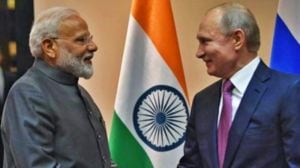Tense history, quiet visit and volunteer service: Rahul Gandhi at Golden Temple
Rahul Gandhi's visits this time, including a night stay nearby and sewa, comes against the backdrop of the Khalistan row
 Congress leader Rahul Gandhi pays obeisance at the Golden Temple, in Amritsar, Monday, Oct. 2, 2023. (PTI Photo)
Congress leader Rahul Gandhi pays obeisance at the Golden Temple, in Amritsar, Monday, Oct. 2, 2023. (PTI Photo) Apart from spirituality and politics, every visit by Rahul Gandhi to Darbar Sahib, or the Golden Temple, is a moment of reconciliation of contradictions, against the backdrop of a violent history.
His visit this time, starting Monday, comes at a time when the Shiromani Gurudwara Parbhandak Committee (SGPC) has been alleging deliberate attempts to spread hate propaganda against Sikhs, following the escalation in India-Canada tensions over the murder of alleged Khalistani extremist Hardeep Singh Nijjar in Canada.
Rahul Gandhi spent a considerable amount of time at Darbar Sahib and participated in volunteer service.
Video: Rana Simranjit Singh @iepunjab @IndianExpress pic.twitter.com/zyHlS5GYhA— Kamaldeep Singh ਬਰਾੜ (@kamalsinghbrar) October 3, 2023
The Congress has taken care to stand behind the Union government in the India-Canada row. Congress leader Jairam Ramesh said last month, “The Indian National Congress has always believed that our country’s fight against terrorism has to be uncompromising, especially when terrorism threatens India’s sovereignty, unity and integrity. Our country’s interests and concerns must be paramount at all times.”
 Rahul Gandhi listening to Gurbani Kirtan at Darbar Sahib. (Express Photo)
Rahul Gandhi listening to Gurbani Kirtan at Darbar Sahib. (Express Photo)
Unlike his previous stints, Rahul will stay in Amritsar for an extended period, with plans to spend the night at a hotel near the Darbar Sahib. During the day, he listened to Gurbani kirtan inside the Darbar Sahib and performed the volunteer service of washing dishes in the community kitchen.
Given the Congress’s history as regards the Golden Temple, which was raided to rid it of armed Khalistanis under the Indira Gandhi government, the SGPC does not accord Rahul the red-carpet welcome given to other political leaders, irrespective of their party affiliations.
Rahul has also kept his visits low-key and uncontroversial.
The first time he visited Sikhism’s holiest shrine was in 2008. Since then, he has been a frequent visitor. In 2017, Rahul had surprised many, including local Congress leaders, when he visited the shrine soon after the Congress formed the government in the state.
 Rahul Gandhi performing volunteer service of washing dishes at Darbar Sahib. (Express photo)
Rahul Gandhi performing volunteer service of washing dishes at Darbar Sahib. (Express photo)
His last visit was in January this year, before embarking on the Punjab leg of his Bharat Jodo Yatra. The kesari turban he wore during that visit had sparked a debate, with detractors saying it brought back memories of the militancy period as ‘kesari’ was the colour used by Sikh militants.
In fact, the Bharat Jodo Yatra visit was the only one seen to have a political agenda, with his other trips private and personal. Rahul has refused to take questions on the issue.
Volunteer services to appease the Guru are central to Sikh beliefs and practices. Such acts also rally the community together, fighting discrimination, because devotees come together to perform menial jobs, irrespective of their economic or social class, caste and creed.
Apart from the Khalistan factor, Rahul’s visit coincides with the tension between INDIA partners Congress and the ruling Aam Aadmi Party over the arrest of Congress leader Sukhpal Singh Khaira. It also comes days ahead of the anniversary of the assassination of Indira Gandhi.
 Rahul Gandhi’s visit comes at a time when the Shiromani Gurudwara Parbhandak Committee has been alleging deliberate attempts to spread hate propaganda against Sikhs, following the escalation in India-Canada tensions. (Express photo)
Rahul Gandhi’s visit comes at a time when the Shiromani Gurudwara Parbhandak Committee has been alleging deliberate attempts to spread hate propaganda against Sikhs, following the escalation in India-Canada tensions. (Express photo)
That, in turn, was the fallout of Operation Blue Star ordered by her government to flush out armed militants holed up inside Golden Temple, with the Army action causing significant damage to the shrine.
Indira’s assassination by her Sikh bodyguards had led to widespread anti-Sikh riots, with known names of the Congress complicit in the same.
The Golden Temple depicts this history vividly, in the form of memorials, portraits, information boards and bullet marks. The SGPC observes the anniversary of Ghallughara (Operation Blue Star) and the death anniversaries of Indira Gandhi’s assassins every year.



- 01
- 02
- 03
- 04
- 05




























